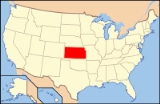
Kansas wine
Encyclopedia
Kansas wine refers to wine
made from grape
s grown in the U.S. state of Kansas
. In the nineteenth century Kansas was a significant grape-growing state. Its latitude, long, sunny growing season and soils ranging from limestone-laced to sandy, provide ideal conditions for growing grapes if the proper varietals are planted.
In the early to mid-nineteenth century, German immigrants established extensive plantings of grapes in neighboring Missouri along the Missouri River, developing a thriving grape and wine culture that spread west into Eastern Kansas. By the 1870s, Missouri and Kansas constituted one of the largest grape growing and winemaking regions in the U.S., with wineries established in Kansas as far west as Russell and as far east as Paola.
Unfortunately for the early Kansas grape and wine industry, the state was also home to Carrie Nation and the early temperance movement
. Kansas was the first state in the union to pass statewide prohibition in 1881.
Vineyard owners did not give up their grapes easily however. As late as 1900, twenty years after prohibition in Kansas, “The Grape in Kansas” published by the state horticultural society documented thousands of acres still existing in Kansas, with detailed statistics regarding cultivars planted, growing techniques and annual yields. Amusingly, however, the cover announced: “To the glory of Kansas, 99 ½ percent of this luscious fruit which grows freely all over the state is used without fermentation.” It was common knowledge, however, that most of the grapes produced were either used for bootleg winemaking in Kansas or sold across the state line to the thriving wine industry in Missouri.
With the advent of national prohibition in 1920, the grape and wine industry in Kansas and Missouri was destroyed. Even after the repeal of prohibition, draconian liquor laws in Kansas prevented the reemergence of the industry until the Kansas Farm Winery Statute was passed in 1985.
As of 2010, there were 23 licensed wineries in Kansas, with many more in the planning stages. Many Kansas wines now routinely win national awards. In 2010, four of the 20 prestigious national Jefferson Cups were awarded to Kansas wines.
Wine
Wine is an alcoholic beverage, made of fermented fruit juice, usually from grapes. The natural chemical balance of grapes lets them ferment without the addition of sugars, acids, enzymes, or other nutrients. Grape wine is produced by fermenting crushed grapes using various types of yeast. Yeast...
made from grape
Grape
A grape is a non-climacteric fruit, specifically a berry, that grows on the perennial and deciduous woody vines of the genus Vitis. Grapes can be eaten raw or they can be used for making jam, juice, jelly, vinegar, wine, grape seed extracts, raisins, molasses and grape seed oil. Grapes are also...
s grown in the U.S. state of Kansas
Kansas
Kansas is a US state located in the Midwestern United States. It is named after the Kansas River which flows through it, which in turn was named after the Kansa Native American tribe, which inhabited the area. The tribe's name is often said to mean "people of the wind" or "people of the south...
. In the nineteenth century Kansas was a significant grape-growing state. Its latitude, long, sunny growing season and soils ranging from limestone-laced to sandy, provide ideal conditions for growing grapes if the proper varietals are planted.
In the early to mid-nineteenth century, German immigrants established extensive plantings of grapes in neighboring Missouri along the Missouri River, developing a thriving grape and wine culture that spread west into Eastern Kansas. By the 1870s, Missouri and Kansas constituted one of the largest grape growing and winemaking regions in the U.S., with wineries established in Kansas as far west as Russell and as far east as Paola.
Unfortunately for the early Kansas grape and wine industry, the state was also home to Carrie Nation and the early temperance movement
Temperance movement
A temperance movement is a social movement urging reduced use of alcoholic beverages. Temperance movements may criticize excessive alcohol use, promote complete abstinence , or pressure the government to enact anti-alcohol legislation or complete prohibition of alcohol.-Temperance movement by...
. Kansas was the first state in the union to pass statewide prohibition in 1881.
Vineyard owners did not give up their grapes easily however. As late as 1900, twenty years after prohibition in Kansas, “The Grape in Kansas” published by the state horticultural society documented thousands of acres still existing in Kansas, with detailed statistics regarding cultivars planted, growing techniques and annual yields. Amusingly, however, the cover announced: “To the glory of Kansas, 99 ½ percent of this luscious fruit which grows freely all over the state is used without fermentation.” It was common knowledge, however, that most of the grapes produced were either used for bootleg winemaking in Kansas or sold across the state line to the thriving wine industry in Missouri.
With the advent of national prohibition in 1920, the grape and wine industry in Kansas and Missouri was destroyed. Even after the repeal of prohibition, draconian liquor laws in Kansas prevented the reemergence of the industry until the Kansas Farm Winery Statute was passed in 1985.
As of 2010, there were 23 licensed wineries in Kansas, with many more in the planning stages. Many Kansas wines now routinely win national awards. In 2010, four of the 20 prestigious national Jefferson Cups were awarded to Kansas wines.
See also
- American wineAmerican wineAmerican wine has been produced for over 300 years. Today, wine production is undertaken in all fifty states, with California producing 89 percent of all US wine...
- Kansas Wine Council Twitter feed

